NEEP602 Course Notes (Fall 1997)
Resources from Space
Solar Energy Resources-Orbiting Solar Power Satellites
1) How They Work
2) Reference Design
3) Key Technology, Environmental, and Economic Issues
4) Comparisons to Other Power Sources
In addition to the mineral and gaseous resources in Space, the energy from the Sun is also an important "energy resource" that could have a far greater impact than it has in the past. The objective of this lecture, the next one (lecture 36), is to illustrate 2 methods by which the enormous energy of the Sun can be harnessed for large scale applications on the Earth. For more information, a recent book edited by Glaser, Davidson, and Csigi (1993) and a recent issue of Solar Energy (1996) are good places to start.
The Big Fusion Reactor in the Sky: the Sun
It is presently believed the bulk of the energy released in the Sun comes from the fusion of protons. See Figure 1. The power in the Sun, some 4 x 1026 Watts, is produced by the burning of ~ 4,000 tonnes of material every second.
 Figure 1
Figure 1Some features of the Sun that are important for this course are listed in Figures 2 & 3. Note that the solar incidence at the Earth (or the Moon) is ~ 1,368 Watts/m2 (Rand McNally (1984) and Duffie & Beckman (1978)). It is also important to note that the sun's energy can be approximated by a black body temperature of 5,762 deg.K and that nearly half of the energy is in the infra-red spectrum where it is absorbed by various molecules.
 Figure 2
Figure 2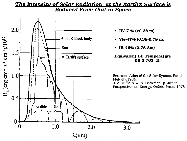 Figure 3
Figure 3There have been 2 major proposals to harness solar energy before it reaches the Earth's surface: the first utilizing orbiting solar platforms and the second using solar cells on the surface of the Moon to collect the sunlight. See Figure 4.
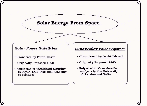 Figure 4
Figure 4In this lecture we will concentrate only on the orbiting Solar Power Satellite (SPS) as described by Glaser et al., (1993), and in the next lecture we will cover the Lunar Solar Power System (LSPS).
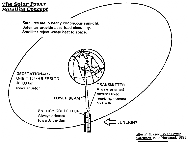 Figure 5
Figure 5More detail on the SPS is given in figure 6 (Kraft (1979). Note that the D.C. electricity from the solar cells is converted to 2.45 GHz microwaves by klystrons and then transmitted to the Earth from a 1 km diameter antenna.
 Figure 6
Figure 6There are 7 major steps which need to be completed before the sunlight is converted to electrical energy and each has an efficiency associated with it. The overall conversion efficiency of the SPS is ~ 7-8% (figure 7). See DOE (1978).
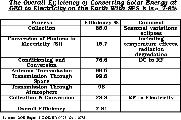 Figure 7
Figure 7The SPS concept, invented by Peter Glaser is nearly 30 years old and Figure 8 summarizes some of the important milestones in that area (Koomanoff and Bloomquist, 1993).
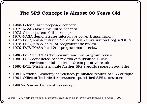 Figure 8
Figure 8The Federal Government organized an extensive review of the SPS concept in the late 1970's and Figure 9 shows the relationships between the National Labs and Industry in this extensive process.
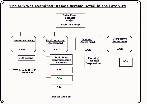 Figure 9
Figure 9Over 40 million dollars (1995$) was spent in 4 years reviewing the SPS concept. See Figure 10.
 Figure 10
Figure 10Some important quantitative design values on the SPS concept are listed in Figures 11a, b, and c (Koomanoff and Bloomquist, 1993).
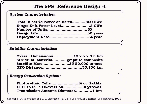 Figure 11a
Figure 11a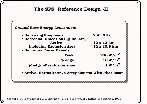 Figure 11b
Figure 11b Figure 11c
Figure 11cAn idea of how big a 12 by 16 km exclusion area is compared to the city of Madison WI is shown in Figure 12.
 Figure 12
Figure 12There were 5 key technological issues that have to be addressed before a successful SPS could be launched and these are listed in Figures 13a & b.
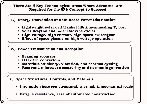 Figure 13a
Figure 13a Figure 13b
Figure 13bThe 5 main environmental/safety issues identified for the SPS concept are listed in Figure 14.
 Figure 14
Figure 14The maximum microwave power density a the rectenna on the ground is ~ 230 W/m2, and it falls to 10 W/m2 at the edge of the collectors and 1 W/m2 at the edge of the exclusion boundary. See Figure 15.
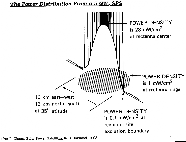 Figure 15
Figure 15The effects of microwaves on humans is not well known, but it is clear that the background from 60 rectenna fields (each producing 5 GWe) will exceed the background by a factor of ~ 100. While probably not a health hazard, the fact that the radiation exceeds the background for a "captive" population means that we almost assured of public protest and delays in implementing this technology. See Figure 16.
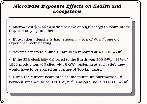 Figure 16
Figure 16Outside of the effects of microwave radiation, the "normal" hazards of working in space to construct SPS platforms are not trivial. Figure 17.
 Figure 17
Figure 17Worker safety issues are summarized in the schematic of Figure 18.
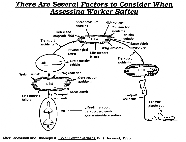 Figure 18
Figure 18Another environmental problem that must be considered is the large amounts of rocket exhaust that will be deposited in various levels of the atmosphere (see Figure 19).
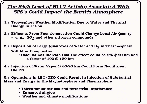 Figure 19
Figure 19Effects of the rocket exhaust will probably be evident in the Troposphere, Stratosphere, Mesosphere, Ionosphere, Plasmasphere, and Magnetosphere (See Figure 20 & Figure 21)
 Figure 20
Figure 20 Figure 21
Figure 21The SPS may also have significant impacts on the optical and radio astronomy fields (see Figure 22)
 Figure 22
Figure 22From a societal perspective, the large land requirements may not be too serious but it has been determined that ~ 40% of the US is suitable for SPS siting. Other societal concerns include International Treaties concerning allocation of GEO locations, possible military uses of the SPS systems, and the changes that will undoubtedly be required of Public and Private Institutions to deal; with the global nature of this technology. See Figure 23.
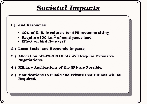 Figure 23
Figure 23Finally, the capital cost of the SPS concept is compared to selected candidates likely to produce large scale electricity in the same time frame (coal, fission, terrestrial photovoltaics) in Figure 24. While the optimistic projections of the SPS system overlap the higher cost estimates of the more conventional power sources, the pessimistic estimates are so high as to essentially preclude its commercial use. The key factor is the cost to launch to LEO which must be less than 75 $/kg in 1995 dollars.
 Figure 24
Figure 24
References
Craft, C. C., 1979, "The Solar Power Satellite Concept", NASA Pub. JSCp- 14898, July 1979.
DOE, 1978, "Satellite Power System Concept Development and Evaluation Program: Reference System Report", DOE report # DOE/ER-0023, Oct., 1978.
DOE, 1981, "An Assessment of the Satellite Power System and Six Alternative Technologies", DOE report # DOE/ER-0099, April, 1981.
Duffie, J. A., and Beckman, W. A., 1978, p. 437 in Perspectives on Energy, Oxford Press.
Glaser, P. E., Davidson, F. P., and Csigi, K. I., 1993, Solar Power Satellites-The Emerging Energy Option, Ellis Horwood, New York.
Koomanoff, F. A., and Bloomquist, C. E., 1993, p. 26 in Solar Power Satellites-The Emerging Energy Option, eds., Glaser, P. E., Davidson, F. P., and Csigi, K. I., Ellis Horwood, New York.
Rand McNally, 1984, Atlas of the Solar System, Chicago.
Representative Questions
1.) Explain how a SPS system might be used as a military threat.
2.) Discuss the potential public reaction to being exposed to microwave radiation far below any known biological effects but 100 times above the background levels.
3.) Are there any precedents in the U. S. for "fencing off" ~ 200 km2 of land which excludes human intrusion?
4.) What is the thermal energy load to the Earth, per kWh of electricity produced, from a SPS system and how does that compare to the thermal load from coal and fission.
 |
|
University of Wisconsin Fusion Technology Institute · 439 Engineering Research Building · 1500 Engineering Drive · Madison WI 53706-1609 · Telephone: (608) 263-2352 · Fax: (608) 263-4499 · Email: fti@engr.wisc.edu |
Copyright © 2003 The Board of
Regents of the University of Wisconsin System.
For feedback or accessibility issues, contact
web@fti.neep.wisc.edu.
|